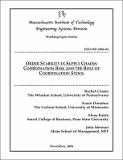Order Stability in Supply Chains: Coordination Risk and the Role of Coordination Stock
Author(s)
Croson, Rachel; Donohue, Karen; Katok, Elena; Sterman, John
Downloadesd-wp-2004-04.pdf (427.7Kb)
Metadata
Show full item recordAbstract
The bullwhip effect describes the tendency for the variance of orders in supply chains to increase as one moves upstream from consumer demand. Previous research attributes this phenomenon to both operational and behavioral causes. Operational causes are features of the institutional setting that lead rational agents to amplify changes in demand, while behavioral causes arise from suboptimal decisionmaking. This paper examines causes of the bullwhip through experiments with a serial supply chain, using the Beer Distribution Game. Unlike prior studies, we control all four commonly cited operational causes of the bullwhip, including uncertainty about customer demand. We eliminate demand uncertainty completely by making customer demand constant and known to all participants. Despite these controls, order amplification, instability, and supply line underweighting remain pervasive. We propose a new behavioral cause of the bullwhip, coordination risk, that arises when players place excessive orders to address the perceived risk that others will not behave optimally. We test two strategies to mitigate coordination risk: (1) holding additional on-hand inventory, and (2) creating common knowledge by informing participants of the optimal policy. Both strategies reduce, but not eliminate, the bullwhip effect. Holding excess inventory reduces order amplification by providing a buffer against the endogenous risk of coordination failure. Such coordination stock differs from traditional safety stock, which buffers against exogenous demand uncertainty. Surprisingly, neither strategy reduces supply-line underweighting. We conclude that the bullwhip can be mitigated but its behavioral causes appear robust.
Date issued
2004-11Publisher
Massachusetts Institute of Technology. Engineering Systems Division
Series/Report no.
ESD Working Papers;ESD-WP-2004-04